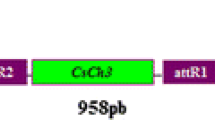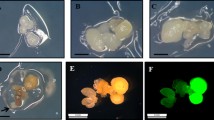Abstract
The aim of the present work was to study the effect of the developmental stage of the somatic embryos and of the genotype on the genetic transformation of embryogenic lines of European chestnut (Castanea sativa Mill.) and the cryopreservation of the embryogenic lines that are generated. As an initial source of explants in the transformation experiments, it was found that the use of somatic embryos isolated in the globular stage or clumps of 2–3 embryos in globular/heart-shaped stages was more effective (30%) than when embryos at the cotyledonary stage were used (6.7%). All of the seven genotypes tested were transformed, and transformation efficiency was clearly genotype dependent. Three transgenic lines were successfully cryopreserved using the vitrification procedure, and the stable integration of the uidA gene into the transgenic chestnut plants that were regenerated subsequent to cryopreservation was demonstrated.




Similar content being viewed by others
Abbreviations
- BA:
-
6-benzyladenine
- DMSO:
-
dimethylsulfoxide
- MS:
-
Murashige and Skoog medium
- NAA:
-
α-Naphthaleneacetic acid
- PVS2:
-
Plant vitrification solution 2
- LN:
-
Liquid nitrogen
References
Aronen TS, Krajnakova J, Häggman HM, Ryynänen LA (1999) Genetic fidelity of cryopreserved embryogenic cultures of open-pollinated Abies cephalonica. Plant Sci 142:163–172
Bergmann BA, Stomp A-M (1992) Effect of host plant genotype and growth rate on Agrobacterium tumefaciens-mediated gall formation in Pinus radiata. Phytopathol 82:1457–1462
Collada C, Casado C, Fraile A, Aragoncillo C (1992) Basic endochitinases are major proteins in Castanea sativa cotyledons. Plant Physiol 100:778–783
Conedera M, Manetti MC, Giudici F, Amorini E (2004) Distribution and economic potential of the sweet chestnut (Castanea sativa Mill.) in Europe. Ecol Medit 30:47–61
Corredoira E, Ballester A, Vieitez AM (2003) Proliferation, maturation and germination of Castanea sativa Mill. somatic embryos originated from leaf explants. Ann Bot 92:129–136
Corredoira E, Montenegro D, San-José MC, Vieitez AM, Ballester A (2004a) Agrobacterium-mediated transformation of European chestnut embryogenic cultures. Plant Cell Rep 23:311–318
Corredoira E, San-José MC, Ballester A, Vieitez AM (2004b) Cryopreservation of zygotic embryo axes and somatic embryos of European chestnut. CryoLetters 25:33–42
Corredoira E, Ballester A, Vieitez FJ, Vieitez AM (2006) Somatic embryogenesis in chestnut. In: Mujib A, Samaj J (eds) Plant cell monogr (2) Somatic embryogenesis. Springer, Berlin Heidelberg New York, pp 177–199
Engelmann F (2004) Plant cryopreservation: progress and prospects. In Vitro Cell Dev Biol—Plant 40:427–433
Fladung M, Kumar S, Ahuja R (1997) Genetic transformation of Populus genotypes with different chimaeric gene constructs: transformation efficiency and molecular analysis. Trans Res 6:111–121
García-Casado G, Collada C, Allona I, Soto A, Casado R, Rodríguez-Cerezo E, Gomez L, Aragoncillo C (2000) Characterization of an apoplastic basic thaumatin-like protein from recalcitrant chestnut seeds. Physiol Plant 110:172–180
Häggman HM, Ryynänen LA, Aronen TS, Krajnakova J (1998) Cryopreservation of embryogenic cultures of Scots pine. Plant Cell Tissue Organ Cult 54:45–53
Hood EE, Gelvin SB, Melchers LS, Hoekema A (1993) New Agrobacterium helper plasmids for gene transfer to plants. Transgenic Res 2:208–218
Humara JM, Marín MS, Parra F, Ordás RJ (1999) Improved efficiency of uidA gene transfer in stone pine (Pinus pinea) cotyledons using a modified binary vector. Can J For Res 29:1627–1632
Jefferson RA (1987) Assaying chimeric genes in plants: the GUS gene fusion system. Plant Mol Biol Rep 5:387–405
Jokipii S, Ryynänen L, Kallio PT, Aronen T, Häggman H (2004) A cryopreservation method maintaining the genetic fidelity of a model forest tree, Populus tremula × Populus tremuloides Michx. Plant Sci 166:799–806
Lambardi M, Fabbri A, Caccavale A (2000) Cryopreservation of white poplar (Populus alba L.) by vitrification of in vitro-grown shoot tips. Plant Cell Rep 19:213–218
Liang H, Catramis CM, Maynard CA, Powell WA (2002) Enhanced resistance to the poplar pathogen, Septoria musiva, in hybrid poplar clones transformed with genes encoding antimicrobial peptides. Biotechnol Lett 24:383–389
Lin YJ, Zhang Q (2005) Optimising the tissue culture conditions for high efficiency transformation of indica rice. Plant Cell Rep 23:540–547
Martínez MT, Ballester A, Vieitez AM (2003) Cryopreservation of embryogenic cultures of Quercus robur using desiccation and vitrification procedures. Cryobiology 46:182–189
Mullins KV, Llewellyn DJ, Hartney VJ, Strauss S, Dennis ES (1997) Regeneration and transformation of Eucalyptus camaldulensis. Plant Cell Rep 16:787–791
Murashige T, Skoog F (1962) A revised medium for rapid growth and bioassays with tobbaco tissue cultures. Physiol Plant 15:473–479
Polin LD, Liang H, Rothrock RE, Nishii M, Diehl DL, Newhouse AE, Nairn CJ, Powell WA, Maynard CA (2006) Agrobacterium-mediated transformation of American chestnut (Castanea dentata (Marsh.) Borkh.) somatic embryos. Plant Cell Tiss Organ Cult 84:69–78
Powell WA, Catranis CM, Maynard CA (1995) Synthetic antimicrobial peptide design. Mol Plant Microbe Interact 8:792–794
Rothrock RE, Polin-McGuigan LD, Newhouse AE, Powell WA, Maynard CA (2007) Plate flooding as an alternative Agrobacterium-mediated transformation method for American chestnut somatic embryos. Plant Cell Tissue Organ Cult 88:93–99
Ryynänen L, Sillanpää M, Kontunen-Soppela S, Timonen H, Kangasjärvi J, Vapaavuori E, Häggman H (2002) Preservation of transgenic silver birch (Betula pendula Roth) lines by means of cryopreservation. Mol Breeding 10:143–152
Sakai A, Kobayashi S, Oiyama I (1990) Cryopreservation of nucellar cells of navel orange (Citrus sinensis Osb. var. brasiliensis Tanaka) by vitrification. Plant Cell Rep 9:30–33
Sakai A (2000) Development of cryopreservation techniques. In: Engelmann F, Takagi H (eds) Cryopreservation of tropical plant germplasm. JIRCAS, IPGRI, Tsukuba, Rome, pp 1–7
Sánchez MC, San-José MC, Ferro E, Ballester A, Vieitez AM (1997) Improving micropropagation conditions for adult-phase shoots of chestnut. J Horti Sci 72:433–443
Valladares S, Toribio M, Celestino C, Vieitez AM (2004) Cryopreservation of embryogenic cultures from mature Quercus suber trees using vitrification. CryoLetters 25:177–186
Vendrame WA, Holliday CP, Montello PM, Smith DR, Merkle SA (2001) Cryopreservation of yellow-poplar and sweetgum embryogenic cultures. New For 21:283–292
Vidal N, Sánchez C, Jorquera L, Ballester A, Vieitez AM (2005) Cryopreservation of chestnut by vitrification of in vitro-grown shoot tips. In Vitro Cell Dev Biol-Plant 41:63–68
Vieitez FJ (1995) Somatic embryogenesis in chestnut. In: Jain S, Gupta P, Newton R (eds) Somatic embryogenesis in woody plants, vol 2. Kluwer Academic Publishers, The Netherlands, pp 375–407
Wenck AR, Quinn M, Whetten RW, Pullmann G, Sederoff R (1999) High-effciency Agrobacterium-mediated transformation of Norway spruce (Picea abies) and loblolly pine (Pinus taeda). Plant Mol Biol 39:407–416
Yeung EC (1995) Structural and developmental patterns in somatic embryogenesis. In: Thorpe TA (ed) In vitro embryogenesis in plants. Kluwer Academic Publishers, The Netherlands, pp 205–248
Acknowledgements
The study was funded by the Ministerio de Educación y Ciencia (Spain) through the project AGL2005-00709.
Author information
Authors and Affiliations
Corresponding author
Rights and permissions
About this article
Cite this article
Corredoira, E., San-José, M.C., Vieitez, A.M. et al. Improving genetic transformation of European chestnut and cryopreservation of transgenic lines. Plant Cell Tiss Organ Cult 91, 281–288 (2007). https://doi.org/10.1007/s11240-007-9295-3
Received:
Accepted:
Published:
Issue Date:
DOI: https://doi.org/10.1007/s11240-007-9295-3




